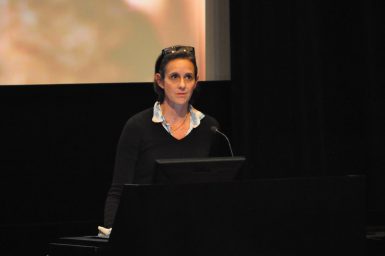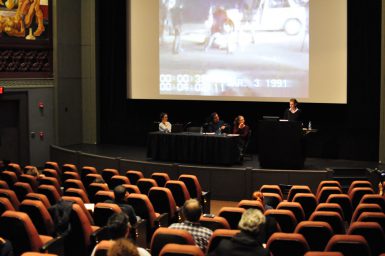Sawyer Seminar speakers focus on film, human rights

Still photography and film can capture a range of human rights issues, according to University of Pennsylvania law professor Regina Austin and University of North Carolina at Asheville political science professor Mark Gibney.
Austin and Gibney presented two talks, “Ironic Iconic: How Images of Black Liberation Protest Movements of the Past Both Inspire and Stifle Contemporary Activism,” and “Seeing Human Rights” as part of the Sawyer Seminar Oct. 21 at the IU Cinema.
The two-day seminar included screenings of documentaries and films that reflect the theme of “Capturing the Imagination: Independence and the Claim to Rights,” as well as other panel discussions and Q&A sessions.
The Friday morning lectures concluded with a panel discussion featuring the two professors as well as IU law professor Timothy Waters.
Austin’s talk focused on well-known black liberation movements, including the Student Nonviolent Coordinating Committee and the Black Panthers, as well as more recent movements like Black Lives Matter. She outlined three eras of black liberation struggles: Nonviolent mass meetings, political efforts and black power as a replacement for integration.
Austin noted that photography was used by activists themselves, which put photographers in the position of finding balance between capturing the moment and working as activists.
“With time, the photographers came to feel tension between the necessity of representing the organization to the media and representing black people to themselves,” she said.
She described problems in how photography through the years has portrayed some of these activist groups, including the lack of photos capturing the service programs of the Black Panthers.

Empowering Voice and Challenging Rights Violations Using Video and ICTs: WITNESS’ Work with Grassroots Activists and Marginalized Communities
Austin suggested that as these problems arise, lawyers must allow clients to represent themselves better through visuals, the “bottom line” of her argument, she said.
“I think that lawyers don’t do a very good job of allowing their clients to speak for themselves. I think that lawyers don’t pay enough attention to the visual,” she said. “If your client is stigmatized, if your clients are a stereotype, part of the source of that is the visual world, and it’s important for lawyers, I think, to become more visually literate.”

The event then transitioned to Gibney’s talk, featuring how documentary and fictional film portrays and furthers human rights issues. He showed clips and comments from films such as Dictator Hunter, Schindler’s List and You Don’t Like the Truth: Four Days Inside Guantanamo.
Gibney described his criteria for assessing what makes a good human rights film. He explained his three-part requirements.
“One is illumination,” Gibney said. “One that made you think differently. It wasn’t just a simplistic account; it made you think of human rights in a different, innovative way.”
Gibney also described issue of complexity in film and how films portray these issues.
“What I don’t like is this didactic nature. I don’t like propaganda films,” he said. “A number of Amnesty International films way back, I thought were just almost like the science films you saw in grammar school. They were just tiresome because of their hectoring format.”
Gibney cited the ability to teach with a human rights film as his third requirement in assessing a film’s quality. He noted that some films are not particularly compatible with a classroom setting.

“This project began because I wanted to use these films in class, and I also think some of the older films, modern audiences couldn’t sift through,” he said.
The two professors were then joined by Waters to further the discussion of film and photos’ benefits and drawbacks. Waters concluded the morning by arguing that images ultimately hold great power in human rights, but it is up to individuals to decide how to use images to harness and control this power.
“The image has a certain kind of power, but it is not an autonomous power alone,” he said. “It’s an ambiguous one that can activate without informing, that can confirm and sometimes pacify. It can make us march, but to where?”
The Media School’s Center for Documentary Research and Practice is sponsoring five Sawyer Seminars over the course of an academic year. This second Sawyer Seminar was organized by Christiana Ochoa, associate director of the IU Center for Documentary Research and Practice.

